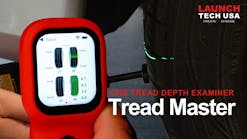Dynamic calibrations
Dynamic calibrations, for the most part, instruct us to verify that the camera, sensor, or radar are properly mounted and leveled. This is where the electronic level/angle gauge is used. A scan tool is used (Figure 1) to put the system into a learn or adaption mode and the vehicle is driven within parameters outlined by service information — and often conveniently laid out on the scan tool — until the calibration is complete. Some carlines, like Chrysler for example, are very nice to us in that they display on the scan tool a percentage leading up to the system calibrating. Others, like Ford and Kia, do not, and you are left driving around waiting for the learn to complete.
There are always outliers, so giving hard numbers for the amount of time for a system to finish calibrating is difficult, but I expect most to complete in 15 to 20 minutes or less. After that time period, I’m often pulling over to the side of the road and checking for any diagnostic trouble codes (DTCs) to give me a clue about potential issues preventing the calibration from completing.
With dynamic calibrations, you need to take into account if a camera is being calibrated, like a forward-facing camera or a radar, like a millimeter-wave radar. Sensor fusion — where there are multiple cameras or a combination of cameras and radar — is being used to accomplish a goal such as autonomous emergency braking or adaptive cruise control. Knowing what is being calibrated can help you with the environment you are driving in. Take, for instance, radar. Radar is probably not concerned with lane markings, but genuinely concerned with obstacles such as trees, guardrails, other vehicles, telephone poles, etc. Cameras may take some of that into account, but a camera really cares about lane markings, especially if it's used for lane keep assist.
Static calibrations
Static calibrations, however, require targets. There’s no beating around the bush here, there are lots of targets. Every manufacturer has their own target designs and even then they often differ by platform (or year range) of their vehicle line-ups.
So, what does it take to do these calibrations (namely the static calibration) in the real world? First of all, you need space and lots of it. Open, flat, properly lit (not too bright), space.
Maybe you have an area in the shop that can be cleared out quickly. Maybe you need to take into consideration leasing or buying a building where you perform calibrations. But the reality is, for many of these calibrations you will need space. Like everything, it depends on the system as to how much you will need. Many aftermarket calibration system manufacturers/distributors suggest a space of 30’ by 45’. But this is a general suggestion and dependent on what vehicles you are serving.
Second, you need to have quality resources for service information. This may seem elementary, but in talking to a few different technicians around the country, I can tell you this isn’t as uncommon as it should be. Depending on the year of vehicle, you may need to subscribe to OEM sites directly. A really good source for how to get OE service information and/or scan tools is nastf.org. You need to be a member, but luckily membership is free. Then just go to the automaker info page (Figure 2) and select the manufacturer of interest.
Third, you are going to have to hit the hardware store. A couple of plumb bobs, masking tape (I prefer the wide painter’s variety), chalk, permanent marker, braided mason’s line, electronic level/angle gauge, laser level (I recommend multiple beam to save time when looking for positions at right angles to vehicle centerline), and a tape measure. Do yourself a favor and make sure your tape measure is metric — specifications are all in the metric system (Figure 3).
And lastly, of course, are the targets themselves. You can choose between OEM and aftermarket. It's challenging when you service multiple carlines, as many vehicle manufacturers don't have guides or bulletins with a list of the required equipment across their vehicle platforms. To determine what you will need, you will need to sift through the procedure, jotting down the equipment “part” numbers, and then calling the dealer service department or finding a distributor, like an online warehouse, to order up the pieces. Be patient when doing this.
Read the full article here.
Voice Your Opinion!
Voice Your Opinion!





